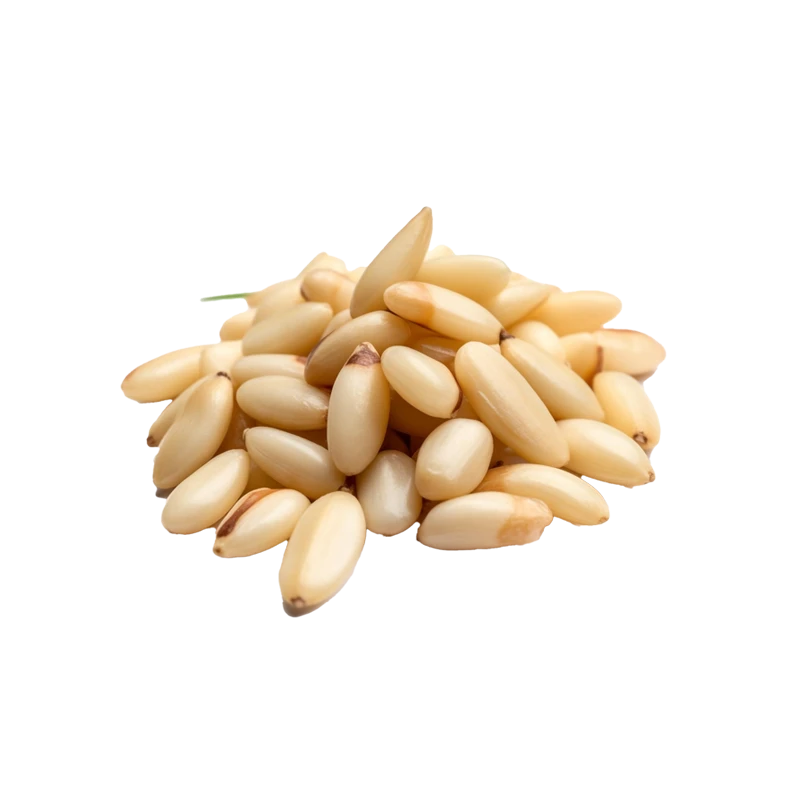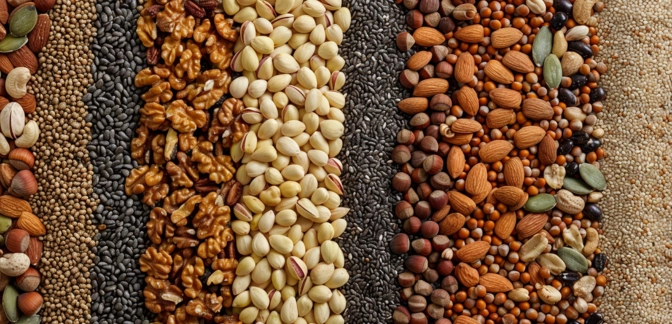Pine Nuts — Nutrients, Health Benefits, And Shopping Tips

Written by Listonic Team
Last update on September 6, 2024
Pine nuts nutrients
Nutrition facts
Amount per 100 g
Calories
🔥 673 kcal
| Nutrition per: 100 g | Value | % Daily Value* |
|---|---|---|
| Carbs | 13 g | 4.73% |
| Fiber | 4 g | 14.29% |
| Sugars | 4 g | 8% |
| Glycemic Index | 15 | - |
| Protein | 14 g | 28% |
| Sodium | 2 mg | 0.09% |
| Total Fat | 68 g | 87.18% |
*The % of Daily Value (DV) tells you how much a nutrient in a serving of food contributes to a daily diet. 2,000 calories a day is used for general nutrition advice.
14 g
🧀 Good Protein Content
15
🟢 Low Glycemic Index
Pine nuts facts & tips
Health benefits
- Rich in healthy fats, particularly monounsaturated fats, which support heart health by reducing bad cholesterol levels.
- High in protein, providing essential amino acids for muscle growth and repair.
- Contains essential vitamins and minerals such as magnesium, Vitamin E, and zinc, which support overall health and well-being.
- Contains antioxidants that help protect the body from free radicals and reduce inflammation.
- Supports digestive health due to its fiber content, promoting regular bowel movements and maintaining a healthy gut microbiome.
Health risks
- High fat content though primarily healthy fats, excessive consumption can still contribute to increased caloric intake and weight gain.
- Potential for allergic reactions in individuals allergic to nuts, causing symptoms like itching, swelling, difficulty breathing, or anaphylaxis.
- Potential for digestive discomfort such as bloating or gas when consumed in large quantities, particularly due to their fat content.
- Risk of rancidity as pine nuts have a high fat content that can cause them to spoil quickly if not stored properly, leading to potential digestive issues.
How to choose pine nuts
Pine nuts should be light golden in color and uniform in size, showing they have been toasted evenly. The nuts should have a crisp texture and not be oily or clumpy, which can indicate freshness and proper storage.
Avoid pine nuts that appear discolored or have a rancid smell, as they are likely past their prime and not suitable for consumption. Containers that are not sealed properly or show signs of damage should also be avoided, as exposure to air can quickly spoil the nuts.

How to store pine nuts
Pine nuts should be stored in an airtight container in the refrigerator or freezer. This extends their freshness and prevents them from going rancid for up to six months.
Exposure to air and heat can cause pine nuts to spoil quickly. Avoid storing at room temperature for extended periods. Proper sealing prevents them from absorbing odors and maintains their delicate flavor.
✅ Extra Tip
How long do they last?
Pine nuts can last for 1-2 months at room temperature when stored in an airtight container. For longer storage, pine nuts can be refrigerated or frozen, lasting up to 6-9 months. Proper storage helps prevent them from becoming rancid and maintains their flavor.
What to do with leftovers?
Leftover pine nuts can be used in a variety of savory and crunchy dishes. Toast them lightly and sprinkle over salads, pastas, or roasted vegetables for added texture and flavor, or mix them into a pesto with basil, garlic, and Parmesan. Pine nuts are also great when used as a topping for pizzas, flatbreads, or grain bowls.
Use pine nuts in a rice pilaf by mixing them with cooked rice, herbs, and dried fruits, or blend them into a smoothie for added richness and creaminess. If you have a lot of pine nuts, consider making a batch of pine nut brittle by cooking the nuts with sugar and butter until caramelized. Pine nuts can also be mixed into a stuffing with breadcrumbs, herbs, and dried fruits, or used as a topping for casseroles or baked dishes. For a quick snack, enjoy pine nuts with dried fruits and cheese, or mix them into a bowl of yogurt with honey and granola.
👨⚕️️ Medical disclaimer
Discover products from other categories
Listonic Team
Fact-checked
Our editorial team checked this article to make sure it was accurate at the time of publishing it.
Get the top-rated shopping list app on your phone!







